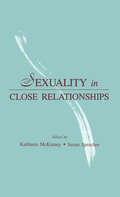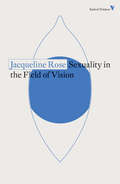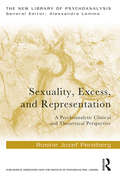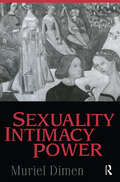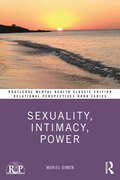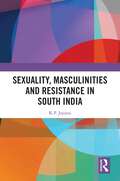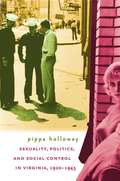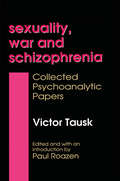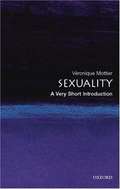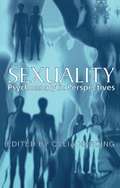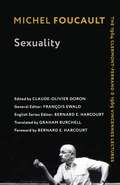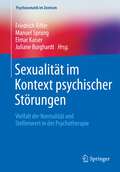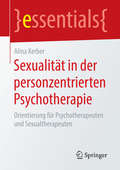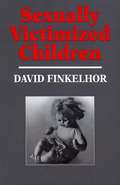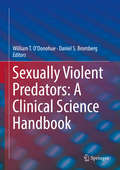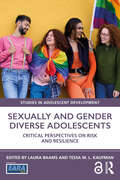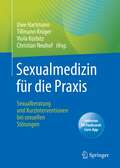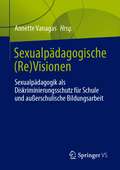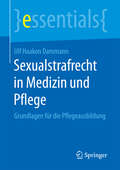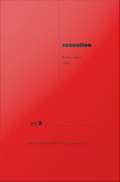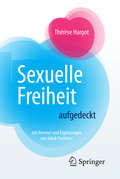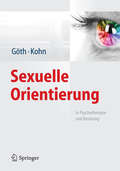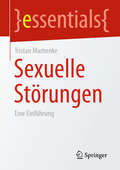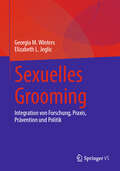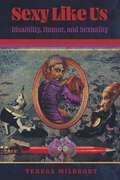- Table View
- List View
Sexuality in Close Relationships
by Kathleen Mckinney Susan SprecherThis is one of the first volumes to examine the interface between research undertaken in sexuality and that in close relationships from a social psychological perspective. Experts from several different disciplines offer chapters that contain theory, extant literature, and their own original research on such topics as jealousy, extradyadic sexuality, communication, love, and sexual coercion. Aimed at a fairly wide audience, this book will be of interest to students, faculty, and other professionals in social psychology, sociology, communication, and family and women's studies. It is also a valuable source of information for teachers, researchers, and clinicians working in the areas of human sexuality and/or close relationships.
Sexuality in the Field of Vision (Radical Thinkers Ser.)
by Jacqueline RoseA brilliantly original exploration of the interface between feminism, psychoanalysis, semiotics and film theory.
Sexuality, Excess, and Representation: A Psychoanalytic Clinical and Theoretical Perspective
by Rosine Jozef PerelbergSexuality, Excess, and Representation develops a psychoanalytic understanding of psychic bisexuality and how it can be understood theoretically and in clinical practice. Rosine Jozef Perelberg articulates a Freudian metapsychology with modern preoccupations with questions of sexual difference and differences. She expands on the ideas presented in her previous book edited work, Psychic Bisexuality: a British-French Dialogue. The author’s approach brings back into focus Freud‘s idea that "one is not born already made as a man or woman, but one is constituted as such in the process of development". Freud’s theoretical writing on bisexuality is examined, returning us firmly to infantile sexuality and the Oedipus complex and the "repudiation of femininity". Perelberg draws on her past training as a social anthropologist to propose and explore the differentiation between sex, gender, and sexuality. She considers post-war academic work in gender and women’s studies and queer theory, arguing that the object of psychoanalysis is not gender but sexuality, which establishes a link between the sexual and the unconscious. She suggests that the unconscious permanently challenges our apparent unity as subjects. Sexuality, Excess and Representation will be of great interest to all practicing psychoanalysts and psychoanalytic psychotherapists.
Sexuality, Intimacy, Power (Relational Perspectives Book Series #22)
by Muriel DimenCan contemporary psychoanalysis tell us anything about sexuality that is new and clinically meaningful? It most certainly can, answers Muriel Dimen in Sexuality, Intimacy, Power, a compelling attempt to revivify Freud's core interest, in "sexual impulses in the ordinary sense of the term." But there is nothing ordinary about Dimen's project. Drawing on contemporary relational theory, feminism, and postmodernism, she takes a sustained, sometimes irreverent, look at assumptions about psychosexuality. For Dimen, the shift from dualism to multiplicity that has reshaped a range of disciplines can also be brought to bear on our thinking about sexuality. She urges us to return to the open-mindedness hiding between the lines and buried in the footnotes of Freud's writings, and to replace the determinism into which his thought has hardened with more fluid notions of contingency, paradox, and thirdness. By unveiling the colloquy among psychoanalysis, social theory, and feminism, Dimen challenges clinicians and academicians alike to rethink ideas about gender, eroticism, and perversion. She explores, among other topics, the relations between Lust and libido; the limitations of Darwinian thought in theorizing homosexuality; the body as projective test; and the intimate tangle of love and hate between women. Generous clinical examples illustrate the ways in which a radical re-visioning of psychosexuality benefits therapists and patients alike. Mixing medium and message, Dimen draws on a variety of disciplines and styles to delineate the ambiguities, contradictions, and paradoxes that subtend sexuality in all its personal and clinical complexity. A brilliant example of contemporary psychoanalytic theory at its destabilizing best, Sexuality, Intimacy, Power is equally a historical document that will intrigue and enlighten students of women's, gender, and queer studies.
Sexuality, Intimacy, Power: Classic Edition (Relational Perspectives Book Series)
by Muriel DimenThis book offers Dimen’s classic take on psychosexuality, drawing on relational theory, feminism and postmodernism, with a new foreword by Virginia Goldner and Velleda Ceccoli honouring the late Muriel Dimen and introducing a new audience to her profound legacy. For Dimen, the shift from dualism to multiplicity that has reshaped a range of disciplines can also be brought to bear on our thinking about sexuality. She urges us to return to the open-mindedness hiding between the lines and buried in the footnotes of Freud’s writings, and to replace the determinism into which his thought has hardened with more fluid notions of contingency, paradox, and thirdness. By unveiling the colloquy among psychoanalysis, social theory, and feminism, Dimen challenges clinicians and academicians alike to rethink ideas about gender, eroticism, and perversion. She explores, among other topics, the relations between lust and libido; the limitations of Darwinian thought in theorizing homosexuality; the body as projective test; and the intimate tangle of love and hate between women. Generous clinical examples illustrate the ways in which a radical re-visioning of psychosexuality benefits therapists and patients alike. A brilliant example of contemporary psychoanalytic theory at its destabilizing best, Sexuality, Intimacy, Power covers both clinical insights and theoretical rethinking that is invaluable for psychoanalysts, psychotherapists, and students of women’s, gender and queer studies.
Sexuality, Masculinities and Resistance in South India
by K.P. JayarajSexuality, Masculinities and Resistance in South India unravels the relations of domination, subordination, and resistance in the context of sexuality and masculinities in contemporary Malabar, South India.Exploring a taxonomy of masculinities, based on the lived experiences of gender and sexual non-conforming men, this book documents the hierarchical character of masculine articulations on the one hand, and forms of everyday resistance to hegemonic masculinity, on the other. It proposes a broad project of social transformation, inclusive of struggles by feminist groups, which should also engage with socially ‘non-conforming’ collectives to challenge the power of masculinities.Sexuality, Masculinities and Resistance in South India will be a valuable text for students and researchers in gender, sexuality, and queer studies, as well as for professionals and activists in these areas.
Sexuality, Politics, and Social Control in Virginia, 1920-1945
by Pippa HollowayIn the first half of the twentieth century, white elites who dominated Virginia politics sought to increase state control over African Americans and lower-class whites, whom they saw as oversexed and lacking sexual self-restraint. In order to reaffirm the existing political and social order, white politicians legalized eugenic sterilization, increased state efforts to control venereal disease and prostitution, cracked down on interracial marriage, and enacted statewide movie censorship. Providing a detailed picture of the interaction of sexuality, politics, and public policy, Pippa Holloway explores how these measures were passed and enforced.The white elites who sought to expand government's role in regulating sexual behavior had, like most southerners, a tradition of favoring small government, so to justify these new policies, they couched their argument in economic terms: a modern, progressive government could provide optimum conditions for business growth by maintaining a stable social order and a healthy, docile workforce. Holloway's analysis demonstrates that the cultural context that characterized certain populations as sexually dangerous worked in tandem with the political context that denied them the right to vote. This perspective on sexual regulation and the state in Virginia offers further insight into why white elite rule mattered in the development of southern governments.
Sexuality, War, and Schizophrenia: Collected Psychoanalytic Papers (History Of Ideas Ser.)
by Victor TauskTausk was a major figure among pre-World War I psychoanalysts and a prominent pupil of Freud. Twelve of his papers are collected here and introduced by Pa Roazen (social and political science, York U.). Indexed by name only. Annotation copyright Book News, Inc. Portland, Or.
Sexuality: A Very Short Introduction
by Véronique MottierIs our sexuality determined primarily by our genes? Or is it shaped by the social norms and expectations we happen to be born into? This Very Short Introduction provides an accessible, thoughtful and thought-provoking introduction to major debates around sexuality in the modern world, highlighting the social and political aspects of sexuality. It critically explores different ways of defining and thinking about sexuality and shows that many of our assumptions about what is "natural" in the sexual domain have, in reality, varied greatly in different historical or cultural contexts. The volume also examines ways in which governments have tried to regulate citizens' sexualities in the past-through policies and laws concerning public health, HIV/Aids, prostitution, and sex education-paying special attention to the particular zeal with which women's sexuality has been policed. The volume concludes by discussing political activism around sexuality more widely, focusing on the ways in which feminists, lesbians and gay men, as well as religious fundamentalists have transformed our ways of thinking about sexuality in the past few decades.
Sexuality: Psychoanalytic Perspectives
by Celia HardingAccording to the popular imagination, psychoanalysis is about men wanting to sleep with their mothers and women wanting penises. Sexuality: Psychoanalytic Perspectives tells a different story about what has happened to sex in psychoanalysis over the past century.In the book, a range of distinguished contributors challenge the view that sexuality is nothing other than historically and culturally determined. Introducing the ideas of sexuality from the viewpoint of a number of theoretical schools, they then go on to offer contemporary psychoanalytic views of* Sexuality in childhood* Female and male sexuality (heterosexual and homosexual)* Sexual perversionsSexuality: Psychoanalytic Perspectives is a comprehensive introduction to the subject, covering its development over the last 100 years, and bringing it up to date for the 21st century. The book will make enlightening and essential reading for both professional and students involved in psychoanalyis, psychotherapy and counselling.
Sexuality: The 1964 Clermont-Ferrand and 1969 Vincennes Lectures (Foucault's Early Lectures and Manuscripts)
by Michel FoucaultMichel Foucault’s The History of Sexuality—the first volume of which was published in 1976—exerts a vast influence across the humanities and social sciences. However, Foucault’s interest in the history of sexuality began as early as the 1960s, when he taught two courses on the subject. These lectures offer crucial insight into the development of Foucault’s thought yet have remained unpublished until recently.This book presents Foucault’s lectures on sexuality for the first time in English. In the first series, held at the University of Clermont-Ferrand in 1964, Foucault asks how sexuality comes to be constituted as a scientific body of knowledge within Western culture and why it derived from the analysis of “perversions”—morbidity, homosexuality, fetishism. The subsequent course, held at the experimental university at Vincennes in 1969, shows how Foucault’s theories were reoriented by the events of May 1968; he refocuses on the regulatory nature of the discourse of sexuality and how it serves economic, social, and political ends. Examining creators of political and literary utopias in the nineteenth and twentieth centuries, from Sade to Fourier to Marcuse, who attempted to integrate “natural” sexualities, including transgressive forms, into social and economic life, Foucault elaborates a double critique of the naturalization and the liberation of sexuality. Together, the lectures span a range of interests, from abnormality to heterotopias to ideology, and they offer an unprecedented glimpse into the evolution of Foucault’s transformative thinking on sexuality.
Sexualität im Kontext psychischer Störungen: Vielfalt der Normalität und Stellenwert in der Psychotherapie (Psychosomatik im Zentrum #5)
by Friedrich Riffer Elmar Kaiser Manuel Sprung Juliane BurghardtSexualität ist ein wichtiger Teil des Lebens. Durch psychische Erkrankungen oder andere Belastungen kann Sexualität gestört werden. Der fünfte Band in der Reihe Psychosomatik im Zentrum widmet sich den Besonderheiten der Sexualität bei psychischer Krankheit, wobei auch körperliche Aspekte, wie z.B. Schmerz nicht zu kurz kommen. Um den Umgang mit sexuellen Themen in der psychotherapeutischen Praxis zu erleichtern, werden viele Gedanken zur Vielfältigkeit von Sexualität dargestellt. Unter anderem geht es um die Enttabuisierung von Homo- oder Bisexualität, die Notwendigkeit unterschiedliche Geschlechtsidentitäten zu beachten und die generelle Schwierigkeit zu definieren was „Normalität“ im sexuellen Kontext sein sollte. Aktuelle kulturelle Entwicklungen haben viele Beschränkungen aufgelöst, gleichzeitig entstehen neue Zwänge zum Beispiel im Falle von kosmetischer Intimchirurgie, die unter dem Einfluss neuer Schönheitsideale Verbreitung findet. Dieser Band vermittelt das notwendige Wissen über die vielfältigen Einflüsse auf Sexualität zum Beispiel durch unterschiedliche Motive, Bindungsstile oder Traumata. Diese Zusammenhänge werden ergänzt durch umfassende Erläuterungen und Bespiele, die es Therapeut*innen erleichtern werden diese wichtigen Themen anzusprechen und in den therapeutischen Prozess einzubeziehen. Dieses Buch richtet sich in erster Linie an Ärzte, Psychotherapeuten, Klinische- und Gesundheitspsychologen sowie verwandte Berufsgruppen.
Sexualität in der personzentrierten Psychotherapie: Orientierung für Psychotherapeuten und Sexualtherapeuten (essentials)
by Alina KerberAlina Kerber befasst sich mit personzentrierten Konzeptualisierungen von Sexualität, insbesondere mit deren Beziehungsdimensionen. Einleitend erläutert sie allgemeine Definitionen und Begriffsbestimmungen sowie soziokulturelle Aspekte von Sexualität. Die Autorin stellt die Herangehensweise an Sexualität im personzentrierten Ansatz – in Abgrenzung zu libidinösen und triebhaften Konzepten – dar. Dabei zeigt sie, dass das personzentrierte Paradigma und tiefenpsychologische Schulen mit der Bedeutung, dem Stellenwert im menschlichen Leben und dem insgesamten Verstehen von Sexualität sehr unterschiedlich umgehen. Sexualität lässt sich als eine mögliche Form der Aktualisierungstendenz begreifen. Die Autorin widmet sich außerdem der Frage, wie sich Sexualität als Ausdruck der Beziehungsgestaltung einer Person verstehen lässt und was kongruente Sexualität im personzentrierten Sinne bedeutet.Die Autorin Mag. Alina Kerber ist Psychotherapiewissenschaftlerin und personzentrierte Psychotherapeutin in freier Praxis in Wien.
Sexually Victimized Children
by David FinkelhorBased on a large-scale survey and in light of demographic and cultural factors, the author examines why children are sexually victimized, the sources of trauma, differences between reported and unreported cases of assault, and possible increases in sexual victimization.
Sexually Violent Predators: A Clinical Science Handbook
by William T. O’Donohue Daniel S. BrombergThis information-rich volume expands current knowledge about sexually violent predators and critiques SVP laws with the goal of fostering improvements in clinical practice and public policy. It offers a finely detailed evidence base on this problematic class of offenders, including the complex interactions of biophysiological and environmental factors that contribute to criminal sexual behavior. Chapters discuss a wide range of assessment issues and instruments central to SVP evaluation, and the possibilities for developing interventions that address individual motivations and behaviors to reduce the risk of reoffending. And throughout, careful attention is paid to ongoing legal, ethical, and logical concerns regarding sexually violent offenders, their treatment and confinement, and their post-confinement placement. Among the topics covered:· Civil commitment of sex offenders.· The physiological basis of problematic sexual interests and behaviors.· Sexually violent predator evaluations: problems and proposals.· Cultural considerations in the assessment of sexually violent predators.· Management of sex offenders in community settings.· Effective use of an expert in sexually violent predator commitment hearings. Offering numerous issues for discussion and debate with considerable implications for clinical practice, policy, and the judicial system, Sexually Violent Predators will interest and enlighten forensic psychologists and psychiatrists as well as social workers, policy-makers, and legal professionals.
Sexually and Gender Diverse Adolescents: Critical Perspectives on Risk and Resilience (Studies in Adolescent Development)
by Laura Baams Kaufman, Tessa M. L.Drawing on psychology, sociology, pedagogy, and prevention sciences, this book offers a comprehensive perspective on the contemporary and complex experiences of sexually and gender diverse (SGD) adolescents worldwide.This important book explores adolescent experiences extending to countries worldwide where issues related to LGBTQ+ rights, adolescent mental health, and social acceptance are of concern. It not only uncovers the intricate world of SGD adolescents and the complexities of resilience, risk, and critical perspectives, but it also explores health and well-being, generational dynamics, societal norms, globalization, and transformative pedagogy. Chapters cover topics including the role of family members, in-school victimization, intimate relationships, the role of social media, gender-affirming care, and generational differences.Focusing on the latest research and moving beyond theory to provide evidence-based strategies, policies, and interventions, this is a must-buy for advanced students and researchers seeking timely and up-to-date knowledge, as well as practitioners, educators, and policymakers looking to effect positive change in the lives of SGD adolescents.The Open Access version of this book, available at http://www.taylorfrancis.com, has been made available under a Creative Commons [Attribution-Non Commercial-No Derivatives (CC BY-NC-ND)] 4.0 license.
Sexualmedizin für die Praxis: Sexualberatung und Kurzinterventionen bei sexuellen Störungen
by Uwe Hartmann Tillmann Krüger Viola Kürbitz Christian NeuhofDas Buch vermittelt klinisch tätigen Ärzten verschiedener Fachbereiche das nötige Praxiswissen und die Fertigkeiten, die dazu befähigen:· Sexuelle Störungen zu erkennen und diagnostisch zu erfassen, inkl. der dazu notwendigen Gesprächsführungskompetenzen· Eine Sexualanamnese durchzuführen· Patienten mit sexuellen Störungen fachgerecht zu beraten· Patienten mit sexuellen Störungen unter systematischer Nutzung der Arzt-Patient-Beziehung und mit Fokus auf der Paardimension sexualmedizinisch zu behandeln und sexualtherapeutische Kurzinterventionen durchzuführen.Das Vorgehen der Gesprächsführung, Beratung und Behandlung beruht auf dem Hannover-Ansatz der Sexualtherapie. Er bietet einen allgemeinen, störungsübergreifenden Rahmen von beratenden und therapeutischen Fertigkeiten und Werkzeugen, die bei allen Patienten mit Sexualstörungen angewendet werden können. Darüber hinaus erhält der Leser die notwendigen spezifischen Kenntnisse über die verschiedenen Sexualstörungen inklusive der für diese verfügbaren aktuellen sexualmedizinischen und sexualtherapeutischen Behandlungsoptionen.Auch ärztliche und psychologische Psychotherapeuten sowie andere Berufsgruppen, die mit sexuellen Problemen konfrontierten Klienten arbeiten, finden in diesem Praxisleitfaden vieles für die tägliche Beratungspraxis. Das Buch deckt die Inhalte der Zusatzweiterbildung „Sexualmedizin“ der Bundesärztekammer sowie des Diploms „Sexualmedizin“ der Österreichischen Ärztekammer ab und vermittelt die dort festgelegten Kenntnisse und Fertigkeiten. Für die Prüfungsvorbereitung stehen dem Leser zahlreiche Flashcards zur Verfügung.
Sexualpädagogische (Re)Visionen: Sexualpädagogik als Diskriminierungsschutz für Schule und außerschulische Bildungsarbeit
by Annette VanagasIn dem Band werden sexualpädagogische Inhalte und deren Potenzial als Antidiskriminierungspädagogik verbunden. Thematisiert werden Homo- sowie Transfeindlichkeit, Geschlechterstereotype und deren Wirkung auf Körperlichkeit, Sexting und Bodyshaming. In ihren Beiträgen nähern sich die Autorinnen und Autoren aktuellen gesellschaftlichen Diskursen und ethischen wie moralischen Fragen und reflektieren deren pädagogische Implikationen.
Sexualstrafrecht in Medizin und Pflege: Grundlagen für die Pflegeausbildung (essentials)
by Ulf Haakon DammannDieses essential ist eine wertvolle Orientierungshilfe zum Thema Sexualstrafrecht f#65533;r Menschen in Pflegeberufen in der Aus-, Fort- und Weiterbildung. Ulf Haakon Dammann liefert eine kompakte #65533;bersicht #65533;ber Erkenntnismerkmale, Definitionen und Beispiele sowie Verhaltensweisen im Umgang mit Opfern (sexueller) Gewalt. Der Autor erl#65533;utert wesentliche Aspekte des Sexualstrafrechts in Deutschland und bereitet diese als Praxistipps f#65533;r Menschen in Pflegeberufen auf.
Sexuation
by Renata SaleclContemporary discourse seems to provide a choice in the way sexual identities and sexual difference are described and analyzed. On the one hand, much current thinking suggests that sexual identity is fluid--socially constructed and/or performatively enacted. This discourse is often invoked in the act of overcoming an earlier patriarchal era of fixed and naturalized identities. On the other hand, some modern discourses of sexual identity seem to offer a New Age Jungian re-sexualization of the universe--"Men are from Mars, and women are from Venus"--according to which there is an underlying, deeply anchored archetypal identity that provides a kind of safe haven in the contemporary confusion of roles and identities. In this volume, contributors discuss a third way of thinking about sexual identity and sexual difference--a direction opened by Jacques Lacan. For Lacan, what we all recognize as sexual difference is first and foremost representative of a certain fundamental deadlock inherent in the symbolic order, that is, in language and in the entire realm of culture conceived as a symbol system structured on the model of language. For him, the logical matrix of this deadlock is provided by his own formulas of sexuation. The essays collected here elaborate on different aspects of this deadlock of sexual difference. While some examine the role of semblances in the relation between the sexes or consider sexual identity not as anatomy but still involving an impasse of the real, others discuss the difference between sexuation and identification, the role of symbolic prohibition in the process of the subject's sexual formation, or the changed role of the father in contemporary society and the impact of this change on sexual difference. Other essays address such topics as the role of beating in sexual fantasies and jouissance in feminine jealousy. Literary and gender theorists, as well as psychoanalytic scholars will welcome this insightful collection. Contributors. Alain Badiou, Elizabeth Bronfen, Darian Leader, Jacques Alain Miller, Genevieve Morel, Renata Salecl, Eric L. Santner, Colette Soler, Paul Verhaeghe, Slavoj Zizek, Alenka Zupancic
Sexuelle Freiheit aufgedeckt
by Thérèse Hargot Jakob Pastötter Lydia LundbeckWas haben wir aus der sexuellen Befreiung gemacht? Nach 50 Jahren sexueller Revolution ist so viel Sex im öffentlichen Raum wie seit der Antike nicht mehr. Doch wie beeinflusst dies die heutigen Jugendlichen? Dieses Buch deckt Auswirkungen und Zusammenhänge der sexuellen Befreiung auf. Basierend auf langjähriger Erfahrung in der schulischen Sexualaufklärung und gestützt durch viele anschauliche Beispiele schildert die Autorin minutiös und bisweilen erfrischend maliziös, was und wie Jugendliche und junge Erwachsene heute über Sexualität denken. Obwohl sich diese sexuell befreit fühlen, unterliegen sie doch vielfältigen Zwängen. Ohne ein Blatt vor den Mund zu nehmen vermittelt die Autorin anhand von vielen Beispielen, welche Auswirkungen Faktoren wie eine Bagatellisierung der Porno-Kultur, permanentes Leistungsstreben, hormonelle Verhütung und eine zwanghafte Suche nach sexueller Orientierung nach sich ziehen. Dabei wird deutlich, dass es ein Irrglaube ist, dass sich die Sexualität als Konsumgut instrumentalisieren und beherrschen, pädagogisch vermitteln, sozial konstruieren sowie pharmazeutisch und chirurgisch optimieren lässt. Das reale Liebesleben könnte sonst viel Leere, Frustration, Verunsicherung und Einsamkeit erfahren. Das Buch regt dazu an, das Wagnis einzugehen, sich den damit verbundenen Fragen des Lebens zu stellen und den Lernprozess der Sozialisierung im Bereich von Liebe, Sex und Beziehungen neu zu überdenken.
Sexuelle Orientierung: in Psychotherapie und Beratung
by Margret Göth Ralph KohnSchwule, Lesben, Bisexuelle in Psychotherapie und Beratung – die wesentlichen Punkte für die PraxisPsychotherapeutinnen und Psychotherapeuten wollen schwule, lesbische und bisexuelle Patientinnen weder pathologisieren noch diskriminieren, sondern vielmehr affirmativ arbeiten. Viele ziehen sich auf emphatisches Verstehen als Instrument der Psychotherapie zurück. Andere sehen eine Lösung darin, die sexuelle Orientierung möglichst nicht besonders zu beachten. Die Folge: Oft wird die sexuelle Orientierung nur oberflächlich benannt, aber ihre Bedeutung für den Klienten nicht erkannt. In einigen Fällen bleibt die sexuelle Orientierung völlig unausgesprochen und unerkannt.Affirmative Therapie kann mehr als „Alles kein Problem mehr, ich behandle alle gleich!“Lesben, Schwule, Bisexuelle durchlaufen als Minderheit in einer heteronormativen Mehrheitsgesellschaft eine spezifische sexuelle Identitätsentwicklung, bei der die Überwindung von Internalisierter Homonegativität die größte Hürde darstellt. Sie sind spezifischem Minderheitenstress und Risikodynamiken ausgesetzt, gegen die sie eigene Ressourcen mobilisieren und Communities schaffen. Praxisnah vermitteln Autorin und Autor Wissen um die Besonderheiten einer nicht-heterosexuellen Entwicklung schwuler, lesbischer und bisexueller Identitäten und Lebenswelten. Sie regen an, die eigene Haltung zur Vielfalt sexueller Orientierung und Identität zu reflektieren, und fördern Handlungskompetenzen. Sie schreiben für Psychologische Psychotherapeuten, psychotherapeutisch tätige Ärztinnen, Berater, Studierende, Psychotherapeutinnen in der Ausbildung und Supervisoren.Eine gute lesbare Reise in nicht-heterosexuelle Lebenswelten von erfahrenen Fachleuten aus Beratung, Psychotherapie, Selbsterfahrung und Fortbildung.
Sexuelle Störungen: Eine Einführung (essentials)
by Tristan MarhenkeDieses essential bietet einen Überblick über Diagnostik, Epidemiologie, Ätiologie und Behandlung sämtlicher sexueller Störungen nach dem Diagnostic and Statistic Manual of Mental Disorder (DSM-5). Bei den sexuellen Funktionsstörungen werden die verzögerte Ejakulation, die Erektionsstörung, die weibliche Orgasmusstörung, die Störung des sexuellen Interesses bzw. der Erregung bei der Frau, die Genito-Pelvine Schmerz-Penetrationsstörung, die Störung mit verminderter sexueller Appetenz beim Mann und die vorzeitige (frühe) Ejakulation erläutert. Von den verschiedenen Paraphilien werden die voyeuristische Störung, die exhibitionistische Störung, die frotteuristische Störung, die sexuell masochistische Störung, die sexuell sadistische Störung, die pädophile Störung, die transvestitische Störung sowie die fetischistische Störung erklärt. Bei den Geschlechtsdysphorien werden die Geschlechtsdysphorie bei Jugendlichen und Erwachsenen sowie die Geschlechtsdysphorie bei Kindern beschrieben. Studious Sophie und Therapy Tara führen den Leser kenntnisreich durch das Buch.
Sexuelles Grooming: Integration von Forschung, Praxis, Prävention und Politik
by Elizabeth L. Jeglic Georgia M. WintersDieses Buch bietet einen ausführlichen Überblick über den aktuellen Forschungsstand zum Thema Sexual Grooming. Es untersucht den Prozess, durch den eine Person, die eine sexuelle Straftat begehen will, ein potenzielles Opfer geschickt in Situationen manipuliert, in denen der Missbrauch leichter begangen werden kann, während gleichzeitig die Offenlegung und Entdeckung verhindert wird. Dieser Band befasst sich mit diesem wenig erforschten Phänomen und untersucht umfassend, was derzeit über dieses Konstrukt bekannt ist. Es bietet eine gründliche Einführung in die Literatur über sexuelles Grooming, wobei der Schwerpunkt auf der Geschichte des Begriffs liegt und darauf, wie sexuelle Grooming-Strategien durch öffentlichkeitswirksame Fälle und solche in Organisationen, die Kinder betreuen (z. B. katholische Kirche, Boy Scouts of America), öffentlich bekannt geworden sind. Das Buch gibt einen Überblick über die verschiedenen vorgeschlagenen Modelle des sexuellen Groomings - einschließlich des Sexual Grooming Model (SGM) -, in denen die übergreifenden Schritte oder Phasen des Prozesses beschrieben werden. Es diskutiert Versuche, das Konstrukt des sexuellen Groomings zu definieren, und befasst sich mit den möglichen Folgen des sexuellen Groomings, wobei der Schwerpunkt darauf liegt, wie Opfer, Familien und Gemeinden im Allgemeinen betroffen sein können. Zu den wichtigsten Themenbereichen gehören: Einzigartige Kontexte und Facetten, in denen sexuelles Grooming-Verhalten beobachtet wurde, einschließlich Online-Grooming, persönliches/Self-Grooming, familiäres Grooming, institutionelles Grooming und Grooming-Verhalten von weiblichen Personen. Die Art und Weise, in der sich sexuelle Grooming-Strategien in Fällen von Sexhandel und sexuellem Missbrauch von Erwachsenen manifestieren können. Bewertung und Behandlung von sexuellem Grooming sowie Präventionsstrategien. Durchführung von Grooming-Forschungen als Grundlage für Strafverfolgungsmaßnahmen und gerichtliche Entscheidungen. Die Ausarbeitung und Verabschiedung von Gesetzen und Strategien zur Verhinderung von sexuellem Grooming. Child Sexual Grooming ist ein unverzichtbares Hilfsmittel für Forscher, Professoren, Studenten, Kliniker, Psychotherapeuten, Juristen, politische Entscheidungsträger, Strafverfolgungsbehörden und verwandte Berufsgruppen in den Bereichen Entwicklungspsychologie, Kinder- und Jugendpsychologie, Sozialarbeit, öffentliches Gesundheitswesen, Kriminologie/Strafjustiz, forensische Psychologie sowie Verhaltenstherapie und Rehabilitation.
Sexy Like Us: Disability, Humor, and Sexuality
by Teresa MilbrodtSexy Like Us: Disability, Humor, and Sexuality takes a humorous, intimate approach to disability through the stories, jokes, performances, and other creative expressions of people with disabilities. Author Teresa Milbrodt explores why individuals can laugh at their leglessness, find stoma bags sexual, discover intimacy in scars, and flaunt their fragility in ways both hilarious and serious. Their creative and comic acts crash, collide, and collaborate with perceptions of disability in literature and dominant culture, allowing people with disabilities to shape political disability identity and disability pride, call attention to social inequalities, and poke back at ableist cultural norms. This book also discusses how the ambivalent nature of comedy has led to debates within disability communities about when it is acceptable to joke, who has permission to joke, and which jokes should be used inside and outside a community’s inner circle. Joking may be difficult when considering aspects of disability that involve physical or emotional pain and struggles to adapt to new forms of embodiment. At the same time, people with disabilities can use humor to expand the definitions of disability and sexuality. They can help others with disabilities assert themselves as sexy and sexual. And they can question social norms and stigmas around bodies in ways that open up journeys of being, not just for individuals who consider themselves disabled, but for all people.
